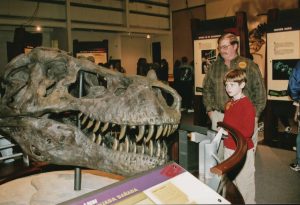
© The Field Museum
Editors: Press materials are available at www.floridamuseum.ufl.edu/pressroom/a-t-rex-named-sue/.
GAINESVILLE, Fla. — The world’s dinosaur “Sue”-perstar returns to the Florida Museum of Natural History on Jan. 24, 2015, in the featured exhibition “A T. rex Named Sue.”
This bilingual exhibit presents the story of “Sue,” the largest, most complete and best-preserved Tyrannosaurus rex ever unearthed. It features a life-size, 42-foot-long cast of the dinosaur and family-friendly interactive components exploring the paleontology that has helped scientists reconstruct Sue’s life and legacy.
In 2002, the Florida Museum was the state’s first venue to host the traveling exhibit, which has been seen by more than 20 million visitors worldwide.
“A whole generation of kids has been born since ‘Sue’ was last here, and the science around dinosaurs is more and more amazing,” said Darcie MacMahon, Florida Museum exhibits and public program director. “The exhibit gives us a great platform for engaging people in a really compelling way while exploring current science.”

Florida Museum of Natural History photo by Kristen Grace
One of the largest flesh-eaters to have ever inhabited the Earth, Sue roamed North America about 67 million years ago. The T. rex is named for Sue Hendrickson, who discovered the dinosaur in 1990 near Faith, South Dakota.
Only a few partial T. rex specimens had previously been discovered, and none were more than 60 percent complete. At 90 percent complete and extremely well-preserved, Sue is the most celebrated representative of its species, allowing new detailed studies of the biology, growth and behavior of T. rex.
“A T. rex Named Sue” follows the dinosaur’s extraordinary journey from the Cretaceous period and sedimentary rocks of South Dakota to the U.S. courts and finally the world. The exhibit explores T. rex’s interactions with its Cretaceous environment, Sue’s instrumental role in unlocking many secrets of the species and the often creative methods of fossil preparation and study.

© The Field Museum
Museum visitors can come face-to-face with the largest T. rex ever discovered, touch casts of Sue’s bones, uncover fossils in a dig pit and learn about Sue’s movement, vision and sense of smell. The exhibit brings Sue to life in a visceral experience that combines sensory activities with fascinating educational content.
The museum will host opening day activities from 10 a.m. to 5 p.m. featuring paleontologists and a variety of real fossils.
While opening day activities are free, admission to “A T. rex Named Sue” is $7.50 for adults ($6.50 for Florida residents, seniors and college students); $4.50 for ages 3-17 and free to museum members and University of Florida students with a valid Gator 1 card.
The Florida Museum will display the exhibit through Sept. 13, 2015.
This exhibition was created by The Field Museum, Chicago, and made possible through the generosity of McDonald’s Corporation.
For more information, visit http://www.floridamuseum.ufl.edu/exhibits.
-30-
Writer: Katina Prokos, kprokos@flmnh.ufl.edu
Source: Darcie MacMahon, 352-273-2053, dmacmahon@flmnh.ufl.edu
Media contact: Paul Ramey, 352-273-2054, pramey@flmnh.ufl.edu